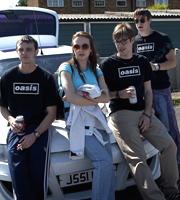How does your media represent particular social groups?
A social group is a group of people who share the same interests. The social groups i represent are people interested in the best of british music past and present, the sterotypical groups they could be range from mods to indie kids. Above are 3 examples from tv shows/films in which my magazine social group would fit into. Programme one is my mad fat diary - its based on a 16 year old girl called Rae who is a mad oasis fan (in the still shot i selected from an episode her and 'the gang' are going to Knebworth to see them) the soundtrack to the show is mostly british artists too, heavily featuring the stone roses. In the second image it is from a short film called Spike Island its is about a rising indie band who travel to spike isalnd in may 1990 to see the stone roses. On the third image it is taken from 500 days of summer, the two people in this still shot are american however during the film they talk about their love of the smiths, in the particular scene in the photo they are at the record shop discussing the beatles. The ages of these actors are 26 so its shows how my magazine can branch out to older people too.
My media magazine represents my social group by all the artists featured on the front:
amy winehouse, arctic monkeys, florence and the machine, the wombats, alt j, blur, ellie goulding, oasis, foals, U2, david bowie, ed sheeran, jamie t, two door cinema club, the libertines and the vaccines. The list of people clearly signifies what genre is inside, as if it was a pop magazine completely different acts would be on the front such as one direction or the wanted. The masthead meaning again represents the group as whenever anybody sings the national anthem they are represnting great britain and the people of it. The tagline best of british also directs at them because they are british so they will feel proud of the british musicians.
The clothes i have selected my models to wear in my photos also represent my particular social group, my main cover star Aidan is wearing typical 'indie' clothes with a plaid shirt and smart coat. With Darius he is wearing casual everyday clothes so the readers and males of the social group can relate to him. I also featured a picture of me and my friend from a party, this will allow the girls to relate by dressing up in nice clothes so my social groups can relate by the reflection of themselves.
Through my article the reader is represented by the interviewer asking questions that they would want to know about the artist such as personal information like superstitions aswell as important music info such as upcoming tours which will excite them/appeal to them. The questions are chatty and informal which if the reader met the act themselves they would not be formal and posh to them so it represents their voice.































